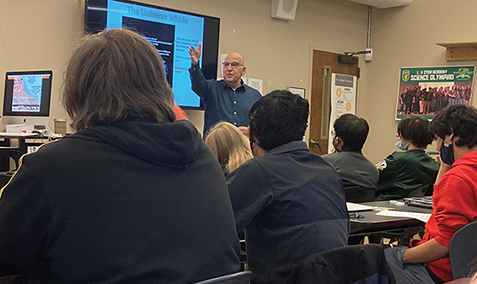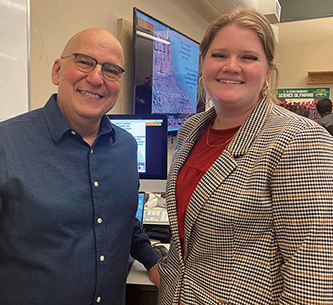Learning World-Class Physics in Their Own Backyard
Nineteen students file in with backpacks and laptops, many bundled up in hoodies against the chill of a gray December afternoon. Among them it’s easy to spot the iconic Chuck Taylors and phones and at least one notebook with colorful sketches, notes, and stickers. They take their seats and chat amiably as they pass around copies of a worksheet they need to complete.
Anthony Mezzacappa will be providing the answers.
This is Brooke Carter’s astronomy class at Knoxville’s L&N STEM Academy, but today she’s ceding the floor to Mezzacappa, professor of physics at UT. He’ll walk students through the death of massive stars—a battle of forces in David and Goliath fashion—as part of a high school academy program where physics faculty bring their work to local schools. That includes topics like quantum physics in everyday life and the cosmic origin of the periodic table.
On this afternoon Mezzacappa is explaining Research on the Origin of the Elements in Your Own Backyard. He asks what comes to mind when students think of the universe.
"Space," one answers. "Finite," says another. "Expansive," says a third. Mezzacappa nods, encouraging more input. He tells them people shouldn’t feel disconnected from the universe because "we’re made of the same stuff.

Anthony Mezzacappa at the L&N STEM Academy, speaking about
"Research on the Origin of the Elements in Your Own Backyard"
"We have 10,000 more atoms in our bodies than there are stars in the universe," he says. "We are 65 percent oxygen."
All of that oxygen comes from the death of massive stars. Over the next hour Mezzacappa leads the class through the cosmic soup, sharing colossal battles between electromagnetic and strong forces and tales of the neutrinos who re-launch shock waves through stars. He talks about how stars are born and die, and how one day Betelgeuse, currently situated comfortably in the constellation Orion, will "go supernova."
The reference to "your own backyard" in his title is literal, he tells them, because UT and Oak Ridge National Laboratory are truly in their backyard and if they have an interest, it’s a great place to learn more about astrophysics. "We’ve worked with high school students," he tells the class. "We’ve published with high school students. So if you’re interested, reach out."
What led Mezzacappa to Carter’s classroom actually began in another Knoxville school five years ago. His children attended West High School and he built on that connection (as well as the school’s International Baccalaureate program) to invite physicists from UT to speak to science classes. A pilot program launched in 2016 with two presentations.
Meanwhile, Carter was finishing her bachelor’s degree in physics at UT ('17) and went on to become a science and math teacher at the L&N STEM Academy. As an undergrad she worked with Professor Kate Jones, who connected her to Mezzacappa, and in 2021 the high school physics academy became the West High School & L&N STEM Academy, with nine guest lectures between the two schools in the fall of 2021.

Anthony Mezzacappa with Brooke Carter (’17)
"The teachers who are willing to do this are the linchpins," Mezzacappa said, referring to Carter and Tommy Eggleston at West High.
He’s working with Knox County Schools to find future candidates, eyeing a slow expansion that grows in the smartest, most sensible way and includes a broader reach of schools across the city. (The name will no doubt change.) The speaker list has expanded to 11 physics faculty and Mezzacappa said new professors are excited about signing on.
The academy has proven to be a hit with students. Carter said they survey classes after talks and the response is overwhelmingly positive.
"It’s a good way to show research that’s actually happening," she said. "What does research look like; what are the applications? The kids love it."
UT Physics faculty evidently love it too.
"The professors are reacting the same way as the kids," Mezzacappa said, and that enthusiasm can be contagious. He knows this from personal experience.
Growing up in New York, he was 16 when he was introduced to relativity and there was, in his words, "no looking back." Ultimately he earned a PhD at the University of Texas at Austin Center for Relativity and went on to become an astrophysicist. Now he helps lead international collaborations from his professorship at the University of Tennessee.
"Part of the motivation is to show them they don’t have to go elsewhere to study physics. We have world-leading groups."
"These kids are just like I was," he said. "Some, I hope, will choose physics because of this program. Part of the motivation is to show them they don’t have to go elsewhere to study physics. We have world-leading groups."
What began as a dad volunteering in the classroom has become a program where high school students hear about international research going on at their hometown university. Mezzacappa said the most important element isn’t all that complicated: commitment from the educators involved.
"It just takes a group of people who really care and know that it’s important to do this," he said.